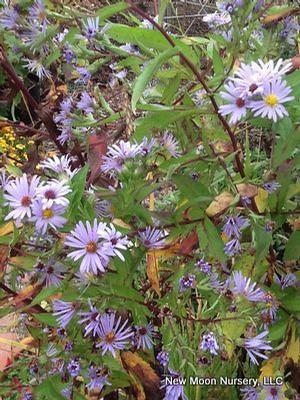Printed at http://www.newmoonnursery.com/index.cfm/
Aster puniceus
Purple stemmed aster
Native to North America
FIRST IMPRESSIONS: Along with the goldenrods and native grasses, asters are the quintessential herbaceous fall color plants of North America. This one is robust and upright with gray-green leaves. Flowering plants are majestic in fall when crowned with sprays of large starry purple daisies. Plants thrive in sunny wet or moist sites.
HABITAT & HARDINESS: Aster puniceus has one of the widest ranges of all the asters. Plants occur through most of Canada. In the Eastern United States, they are distributed from the edge of the Great Plains, along the shores of the Great Lakes to the Atlantic Coast and south to Georgia and Alabama.
Habitats include moist thickets, bog and marsh edges, creek and stream banks, calcareous seeps, sedge meadows and other high quality wetlands. Indigenous plants grow in soggy soil but are intolerant of standing water.
Plants are hardy from USDA Zones 3-8.
PLANT DESCRIPTION: Aster puniceus is a sturdy clump forming perennial that grows from underground rhizomes. Plants produce stiff reddish purple stems that branch along their upper third.
Leaves are lance shaped and up to 6” long. Lower leaves clasp the stem and upper leaves are tiny and sessile.
Large flower heads are arranged in showy panicles. The heads consist of a ring of 30 or more lavender, violet or purple ray florets that surround a central cluster of yellow or rose colored disc florets.
Because this is one of the latest asters to bloom, it serves as a valuable late season pollen and nectar source for butterflies, skippers and bees.
Plants grow 3-6’ tall with 2-3’ spread.
CULTURAL & MAINTENANCE NEEDS: Aster puniceus grows best in wet or moist sunny sites.
Plants tolerate some drought but unattractive or diseased foliage may develop if drought is severe. Plants may also die out in the center if they are not divided periodically.
Plants are fairly unpalatable to browsing deer and rabbits.
LANDSCAPE USES: This is a good choice for a Water Garden, Wildlife Garden, Moist Prairie or Meadow. Plants are also used as Butterfly Nectar Plants, Butterfly Host Plants or as part of a Grouping or Mass Planting. Aster puniceus has Showy Blooms and is appropriate for Cottage Gardens, Deer Resistant Plantings, Low Maintenance Plantings, Perennial Borders, Roadsides and Restoration Projects.
COMPANION & UNDERSTUDY PLANTS: Try pairing Aster puniceus with Asclepias incarnata, Rudbeckia subtomentosa, Liatris spicata, Solidago sempervirens, Carex bicknellii and Andropogon gerardii.
Aster novae-angliae would be a suitable replacement due to similar height, flower color and habitat needs. Aster novae-angliae ‘Purple Dome’ could serve as lower growing alternative.
TRIVIA: Many of the established Latin names of Aster spp. were changed recently due to DNA and genetic research findings. So Aster puniceus is now known as Symphyotrichum puniceum.
Plants host caterpillars of Silvery Checkerspot Butterfly, Pearl Crescent Butterfly and several different moths.
Aster puniceus is similar in appearance to Aster novae-angliae. Differences in the two include that A. puniceus has slightly smaller flower heads, fewer widely spaced ray flowers and smooth almost glossy foliage.
Some Botanists divide Aster puniceus into two or more subspecies. Some even classify one of the subspecies as a separate species – A. firmus.
Height:
3-6 ftSpread:
2-3 ftSpacing:
4-6 ftUSDA Hardiness Zone:
3-8Bloom Color:
Light BlueAster puniceus Characteristics
Attracts Wildlife
- Butterflies
Attributes
- Rain Garden
- Naturalizing
- East-Coast Native
- Cut Flower
- Bog
Exposure
- Full Sun to Partial Shade
Flowering Months
- September
- August
- October
Foliage Color
- Green
Growth Rate
- Medium
Juglans nigra Tolerance (Black Walnut)
- Yes
Salt Tolerance
- Medium
Soil Moisture Preference
- Wet to Moist
Interesting Notes:
AKA Symphyotrichum punecium
For more information on this plant, visit the USDA PLANTS Database:http://plants.usda.gov/java/profile?symbol=SYPUP

